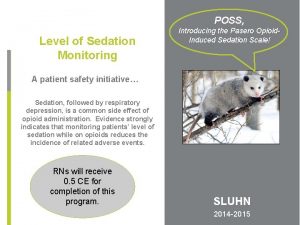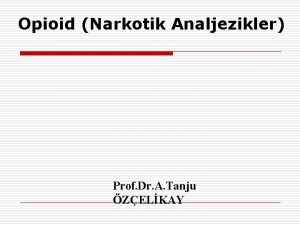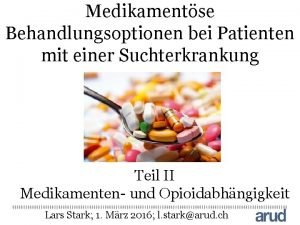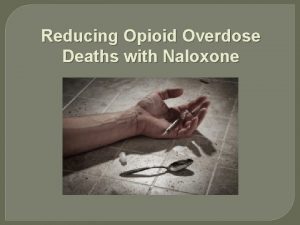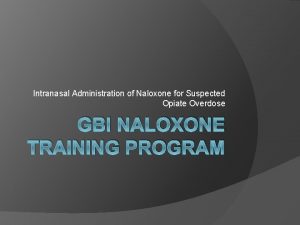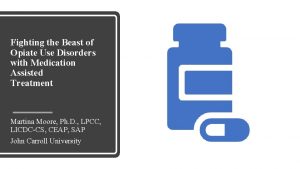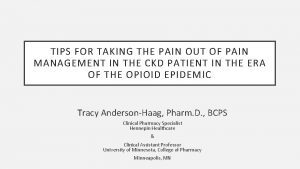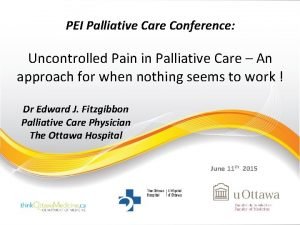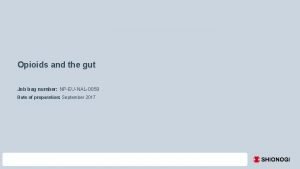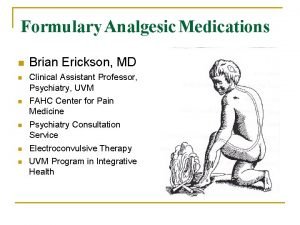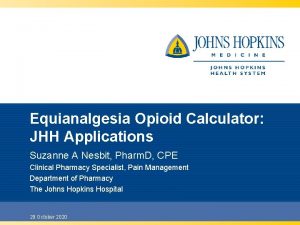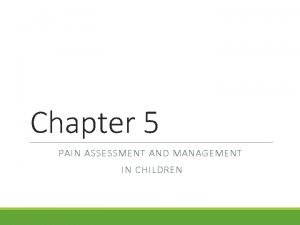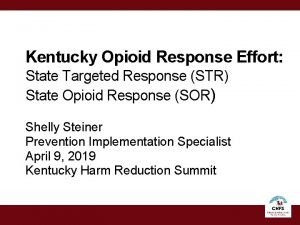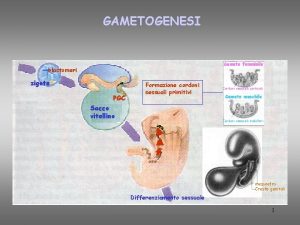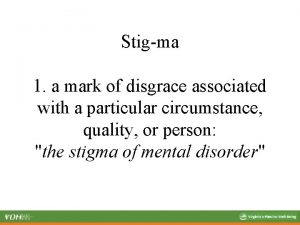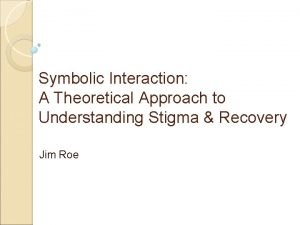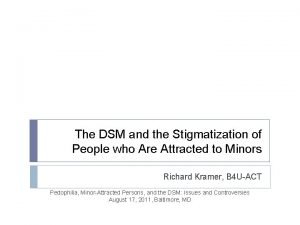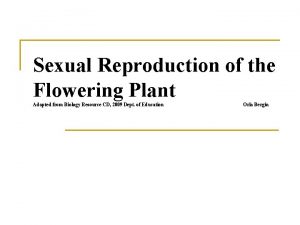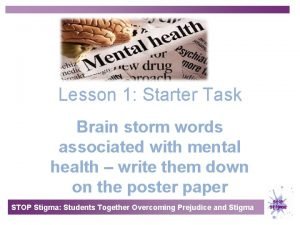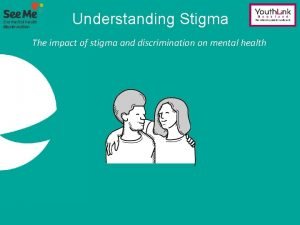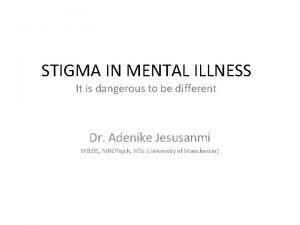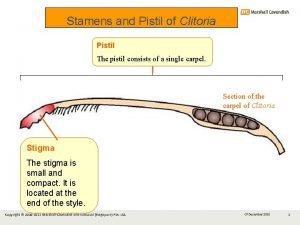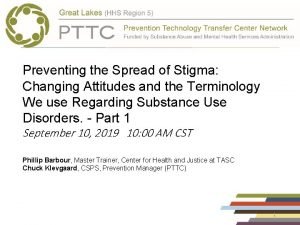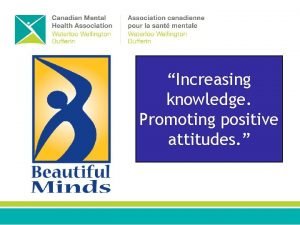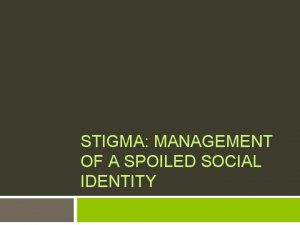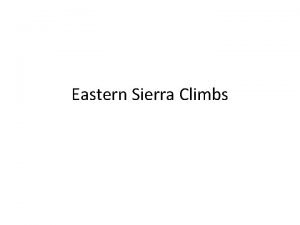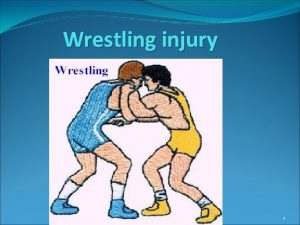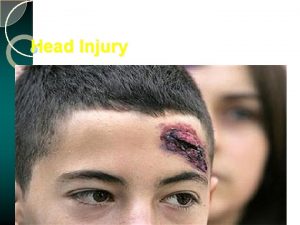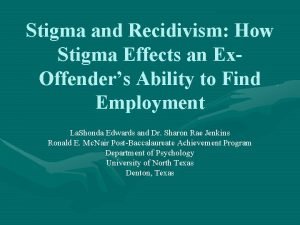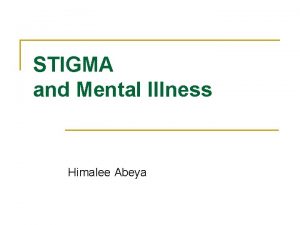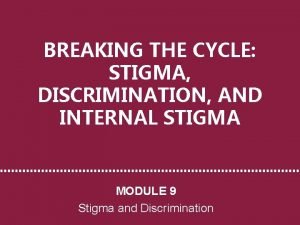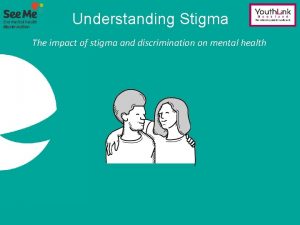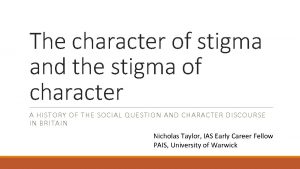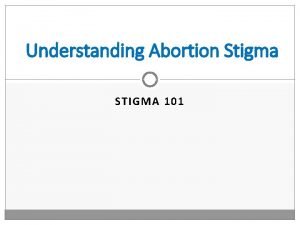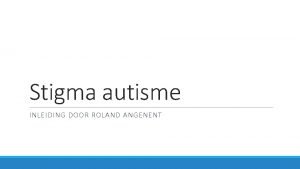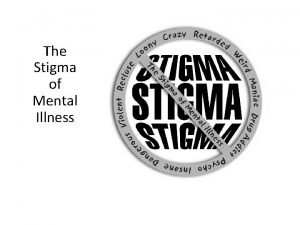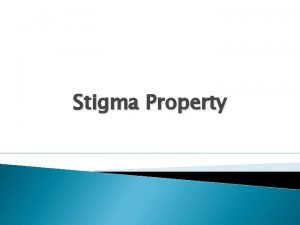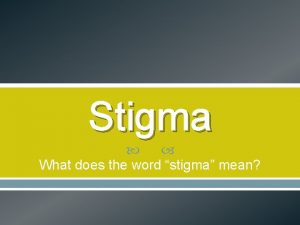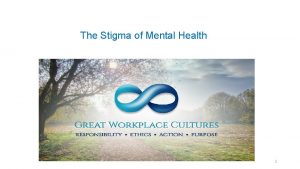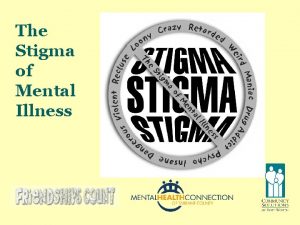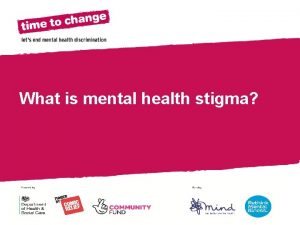Stigma and Stigma Injury EASTERN SIERRA OPIOID SUMMIT







































- Slides: 39

Stigma and Stigma Injury EASTERN SIERRA OPIOID SUMMIT JULY 22 -23, 2019 GRACE KATIE BELL MSN RN-BC CARN PHN TELEWELL INDIAN HEALTH MAT PROJECT

Stigma and Stigma Injury Presenter does not have any financial or corporate affiliations to report Bell 2019

Learning Objectives Describe three ways where repeated Stigma Injury impacts the wellness of an individual. Identify three ways to de-stigmatize substance use disorder and behavioral health language. List three types of stigma. Stigma directly impacts outcomes in the care of people with substance use disorder. Name two ways this happens.

Optional Bell 2019 Take the Anonymous Stigma Survey

Bell 2019

Stigma Bell 2019 Stigma assumes many forms. It appears as prejudice, discrimination, fear, shame, distrust, and stereotyping.

Stigma – in our thinking, attitude and our language Bell 2019 Stigma is shaped by our thinking – a bias and perception that substance users are “bad” and immoral rather than ill with a chronic condition requiring care and treatment. Often there is more than one chronic condition such as mental health disorders which also require care. Stigma is communicated by tone, interpersonal attitude, body language. Stigma is communicated by words. Stigma becomes internalized by the person seeking help. The person views themselves as bad, as dirty, as weak which fuels the shame of stigma.

A Guide to Acronyms and Terms Bell 2019 MAT – Medication-Assisted Treatment or Medications for Opioid Use Disorder (MOUD) OUD – Opioid Use Disorder Stigma – barrier to care communicated by language, judgmental attitude and because of this judgment, decrease in quality of care. Diversion – trading, sharing, stealing, selling, buying illegal or prescribed controlled medications and substances. Misuse – replaces the word abuse. Taking more than prescribed, using non-prescribed opioids including IV heroin.

Stigma contributes to the slow, under-funded response to the opioid epidemic “For far too long, too many in our country have viewed addiction as a moral failing. This unfortunate stigma has created an added burden of shame that has made people with substance use disorders less likely to come forward and seek help. It has also made it more challenging to marshal the necessary investments in prevention and treatment. We must help everyone see that addiction is not a character flaw – it is a chronic illness that we must approach with the same skill and compassion with which we approach heart disease, diabetes, and cancer. ” - Facing Addiction in America The Surgeon General’s Report on Alcohol, Drugs and Health 2017 Bell 2019

Stigma is pervasive and pernicious – and found within the walls of care Substance use behaviors are linked symbolically to a range of other stigmatized health conditions [e. g. human immunodeficiency virus/acquired immune deficiency syndrome (HIV/AIDS), hepatitis C virus, mental illness], unsafe behaviors (e. g. impaired driving) and social problems (e. g. poverty, criminality). These negative stereotypes guide social action, public policy and the allocation of health-care expenditures. Therefore, people with substance use disorders may experience stigma as a consequence of the culturally endorsed stereotypes that surround the health condition. Livingston, J. et al, The effectiveness of interventions for reducing stigma related to substance use disorders: a systematic review. Addiction. 2012 doi: 10. 1111/j. 13600443. 2011. 03601. x

Stigma contributes to poor care “Health professionals may have an avoidant approach to delivery of care with substance use disorder patients compared to other patient groups may result in shorter visits, expression of less empathy, and less patient engagement and retention. ” (Kelly, 2016) • “What to do about stigma: education, personal witness, shift language/terminology. ” (Kelly, 2016) Kelly, J. Overcoming Addiction 2016. https: //www. massgeneral. org/psychiatry/newsarticle. aspx? id=6001

Stigma is discrimination - seek justice Justice in every aspect of substance use care requires persistent advocacy calling for fair policies and laws, true insurance parity, education throughout healthcare, schools and community organizations. Because of the slow response to the opioid epidemic, our people with opioid use disorders have spiraled further down into homelessness, incarceration, unemployment, broken families and death. The struggle to find adequate care for our patients is a case management challenge (nightmare!) – piecing together a patchwork of care. Justice = Adequate funding for effective evidence - based care and the resources to establish whole person wellness. Bell 2019

Recovery Bill of Rights https: //facesandvoicesofrecovery. org/ Bell 2019

Bell 2019

A recent quote from a recovering person “The stigma is the main reason we don’t continue treatment indefinitely. When we are seen as bad, we want to get good as fast as we can and when the job is done, we want to distance ourselves from things and places that make us look like bad people. If we can be seen as sick and brave for fighting a terrible and fatal illness our numbers would be so much better. ” - Steve Bell 2019

Self - stigma Internalized shame and self-condemnation and internalized hopelessness - the most deadly aspect of stigma. Street language – “dope fiend”, “junkie”, ”dirty”, “clean” “subs”, “black” Medical, Behavioral Health staff, Substance Use Counselors can be inclined to use street language to be more approachable to persons with SUD. Important to use dignifying language. Bell 2019

Social Stigma - within the rooms The 12 Step Peer Support groups offer support and help in sustaining sobriety. Recovery support can be life saving. 12 Step programs are in a time of adjusting to include Harm Reduction values. “Practicing medicine through the culture” – dogma, sponsors, culture From the Twelve Traditions of Narcotics Anonymous: Tradition 10. Narcotics Anonymous has no opinion on outside issues; hence the NA name ought never be drawn into public controversy. Bell 2019

Stigma within families Bell 2019 The shame around substance use disorders often starts in childhood with parents with alcohol or drug problems. This leads to early isolation and exclusion and internalized shame. Because of shame, families tend to struggle in secret. “We are only as sick as our secrets. ” Strong parental resistance have been the reason patients decline buprenorphine and methadone treatment because of their views often informed by internet conversations, community prejudice and the fear of a new dependency. Solution: educate parents. With patient’s permission, meet with the parent and the patient to answer questions about the treatment and plan of care.

Stigma within communities Bell 2019 Native Culture and Traditions Recovery care in native communities is usually 12 -Step informed with buprenorphine and methadone treatment considered as ‘still using’. Not accepting of those receiving MAT care. Excluded from ceremonies and sweat lodge where complete abstinence is required. Understandably suspicious of mainstream medical treatments especially after the harm coming from long term opioid therapy for chronic pain. Church and religious culture Substance use disorders have long been viewed as a sin. Returning to worship is a strong sign of recovery.

The effects of stigma Bell 2019 Stigma stops people from seeking treatment because of the fear that they will not be treated with respect or dignity within the treatment system. Powerful and pervasive, stigma prevents people from acknowledging their substance abuse problems, much less disclosing them to others.

The effects of stigma Bell 2019 Stigma deters the public from wanting to pay for treatment, reducing access to resources and opportunities for treatment and social services. Stigma stops people from seeking help for fear that the confidentiality of their diagnosis or treatment will be broken. It gives insurers—in both the public and private sectors—tacit permission to restrict coverage for treatment services in ways that would not be tolerated for other illnesses.

Structural/institutional Stigma Because Emergency Departments and county jails have been the default detox settings for persons with opioid use disorders, these settings provide a unique and important opportunity to de-stigmatize the care. Bell 2019 CA Bridge program has taken a powerful lead. https: //ed-bridge. org/ North Inyo Hospital has received CA Bridge grant. A MAT program patient recently shared about Suboxone in a local NA meeting and someone in the group suggested that they no longer share because they are on suboxone and not “clean”. The discussion of tapering off of buprenorphine with providers and counselors is often couched in the context of not being viewed as abstinent. Or in the context that the patient is using a ”crutch”.

Institutional Stigma – Justice System Bell 2019 Courts – it has taken the judges some years to recognize the importance of evidence–based care. For many years when patients were ordered into treatment the judge would tell them to come off of buprenorphine or not to start it. Law Enforcement – powerfully impacted and overwhelmed by overdoses and crime. Local PD and County Sheriff’s need support and education Jails – slowly beginning to introduce buprenorphine. Our MAT program patients are now continued on buprenorphine at our county jail. Not yet treated with buprenorphine if not in a MAT program. Some counties are insisting on buprenorphine care in new contracts with jail medical providers such as CFMG. California Forensic Medical Group.

Structural/Institutional Stigma Recovery settings have been almost entirely 12 Step-informed with the tenet of abstinence from all drugs and alcohol as a core recovery value. Oddly, this has not included caffeine and nicotine. Residential and outpatient treatment facilities remain a vector of stigmatizing ideas and language. Using the Dirty/clean language for lab results is still universal. Culture change can take time. Hazelden-Betty Ford (the Minnesota Model) has only in recent years begun to offer maintenance with buprenorphine and to publicly support harm reduction with medications for OUD as valid care. Bell 2019

Recovery Settings Bell 2019 Initially, it was almost impossible to locate a residential setting which “allowed” buprenorphine. This denial of care lasted for years. SUD Counselors continue to encourage patients to ‘taper off’ suboxone quickly in the face of evidence of high risk for relapse if buprenorphine stopped too early in the recovery process. State of California now requires buprenorphine care for any beds funded by DMC-ODS.

Structural/institutional Stigma Routine screen in primary care: Are the CAGE-AID questions stigmatizing? Respectful? Intrusive? C. Have you ever felt that you ought to cut down on your drinking or drug use? A. Have people annoyed you by criticizing your drinking or drug use? G. Have you ever felt bad or guilty about your drinking or drug use? E. Eye-opener: Have you ever had a drink or used drugs first thing in the morning to steady your nerves or to get rid of a hangover? Bell 2019

Stigmatizing language no longer used “Abuse” as in Substance Abuse. Was identified as the only diagnosis which had the word abuse. “Misuse” or “Use”. “Addict” – rather, person with substance use disorder or people who inject drugs or opioid users. Still used in 12 Step culture as a part of the recovery process. “Drug-seeking” – can be re-framed as “relief-seeking”. Focus on the person rather than the behavior. “Nodding Out” – a street term that is used to describe sedation caused by too many opioids or combining opioids with other sedating drugs. Bell 2019

50 Bell 2019

Urine Drug Screens - Labs In medicine, we do not refer to lab results as “clean” or “dirty”, we use medical language at all times to support the dignity of our patients. We say consistent or inconsistent or appropriate or inappropriate. If we say “Positive” or “Negative”, we need to be specific: “positive for opioids” or “positive for methamphetamine” for example.

Stigma is a secondary injury of substance use and can require care. Bell 2019

The Stigma Injury – how to treat Begin with acknowledgement of the injury caused by stigma Symptoms can be fear of Emergency Departments, distrust of medical providers; feelings of shame and dishonesty. If not treated, the person internalizes the shame and low-self worth caused by stigma OFFER Generous DOSES OF: Dignity + Empathy + Compassion + Kindness + Respect + Listening Bell 2019

The stigma injury – how to treat Openly and directly acknowledge to the person that stigma has contributed to their suffering. Humility exhibited by medical providers and care teams is a balm to the stigma injured. Develop trauma-informed care and understand that stigma is traumatizing for people seeking help. For some it has been decades of disrespect and harsh judgements and minimal care. Stay focused on the human being and bring respectful, compassionate interventions to addictive behavior and to destructive choices. Partner with our patients, develop and offer choices and options throughout the care visits. Keep the doors open to care in the face of relapse. ”This door will always be open to you. ” Bell 2019

Pathway of Care Trauma-informed care is essential with opioid use disorder Education and Support Level of Care per ASAM criteria Case Management – refers based on LOC Referrals to outside Recovery Providers Referrals to community resources Clear expectations Phases of Care Refill/Stabilization Groups Bell 2019

The Solution: Recovery and Wellness Culture and Tradition Bell 2019 White Bison /Red Road to Wellbriety Restoration of wellness Understanding impact of historical trauma 12 Step support Healers and Artists Culture and Identity Behavioral Health Life Directions Restored Relationships

The Solution – Access to care Addiction Treatment Starts Here Increase access to care – Open doors to treating Opioid Use Disorder Develop a Medication-Assisted Treatment program Community Outreach and Education No Wrong Door – have an effective referral system Evaluate all barriers and adjust for improved access. Bell 2019

Policy Recommendations for addressing stigma and discrimination Bell 2019 Provide meaningful insurance coverage for addiction treatment. Enforce public and private insurance consumer protective requirements Support Education and Outreach to healthcare professionals and criminal justice officials. Treat justice-involved individuals. Promote treatment and recovery while incarcerated.

Bell 2019

De-stigmatizing is ongoing work: With ourselves, our families, our communities, our cultures, our programs of care, our agencies, our institutions, and our laws. “Be the Change You Wish to See in the World. ” ~ Mahatma Gandhi Bell 2019

Acknowledgements Bell 2019 “Addiction Stigma” - John Bachman Ph. D 2018 Anti-Stigma Toolkit: A Guide to Reducing Addiction-Related Stigma. Danya Institute. Central East Addiction Technology Transfer Center. Thank you to the many people in my life who have demonstrated courage and commitment to healing in the face of great odds and in the face of persistent stigma.
 Eastern sierra observatory
Eastern sierra observatory Intentional and unintentional injury
Intentional and unintentional injury Pasero opioid induced sedation scale
Pasero opioid induced sedation scale Opiyatlar grubu
Opiyatlar grubu äquivalenzdosis opioide
äquivalenzdosis opioide Opioid overdose
Opioid overdose Opioid overdose
Opioid overdose Opioid overdose
Opioid overdose Types of pain
Types of pain Mechanism of action of opioid analgesics
Mechanism of action of opioid analgesics Acetaminophen analgesic
Acetaminophen analgesic Opioid receptors location
Opioid receptors location Non-opioid
Non-opioid Suzanne nesbit
Suzanne nesbit Non-opioid
Non-opioid Kentucky opioid response effort
Kentucky opioid response effort Advantages and challenges of multigrade teaching
Advantages and challenges of multigrade teaching Inc
Inc Part of flower comprising stigma style and ovary
Part of flower comprising stigma style and ovary Root parts
Root parts Follicolo preantrale
Follicolo preantrale Hypocotyl
Hypocotyl Chi xi stigma
Chi xi stigma Stigma image
Stigma image Associatief stigma
Associatief stigma Symbolic stigma
Symbolic stigma Stigma image
Stigma image Stigma function
Stigma function Stigma image
Stigma image Stigma bunga
Stigma bunga What is stigma
What is stigma Tribal stigma
Tribal stigma What is stigma
What is stigma Diagram of germination of pollen on stigma
Diagram of germination of pollen on stigma Formula sigma
Formula sigma Stigma definition
Stigma definition What is stigma
What is stigma What is stigma
What is stigma Euglena parts and functions
Euglena parts and functions Stigma symbol
Stigma symbol


